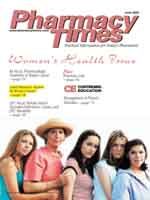CASE STUDIES
Case ONE: OS, a 26-year-old woman, presents to the Emergency Department of the local hospital complaining of difficulty breathing and a pruritic rash. She had been in her usual state of health until the morning of admission. She first noticed the rash and felt feverish over her entire body an hour after sharing a peanut butter and jelly sandwich with her 3-year-old daughter. During the next 30 minutes, she experienced difficulty breathing and felt "swollen," especially around her face.
OS has a medical history that is significant for asthma and hypertension. Her current medications include an albuterol metered-dose inhaler as needed for shortness of breath, a fluticasone inhaler 2 puffs twice daily, and hydrochlorothiazide 25 mg daily. She has no known medication allergies.
Her vital signs are reported as follows: blood pressure 160/95 mm Hg, heart rate 95 beats/min, respiratory rate 25 breaths/min and labored, and temperature 39.8̊C. On physical examination, OS is found to be a well-developed and wellnourished woman in acute distress. Her face and neck are edematous and swollen. A red maculopapular rash is prominent on her cheeks and forehead. Also, the same rash is present on her abdomen and upper extremities.
There are no lesions on her mucous membranes or eyelids. Her heart sounds are normal. In all lung fields, bronchial, wheezing breath sounds are audible, along with "barking" sounds on expiration. Due to the timing of the symptoms and her history of asthma, the emergency room physician suspects that OS is experiencing an allergic reaction to peanut butter.
What should be the initial treatment for her anaphylaxis?
Case TWO: UC, a 40-year-old man, brings 2 prescriptions to be filled at Seaside Pharmacy. The prescriptions are written for an epinephrine self-injector and celecoxib (Celebrex). UC explains that he has had an anaphylactic reaction to sulindac. The pharmacist documents this new allergy in UC's profile. She also notices that UC had just filled the sulindac a few days ago.
While the pharmacist is entering the prescription information into the computer, UC expresses his frustration and anxiety because he never knows when he is going to have an allergic reaction to a medication and when he will have no adverse effects. The pharmacist notices that UC also has a documented allergy to hydrochlorothiazide. UC states that he has experienced an anaphylactic reaction to that medication as well. He explains that he has tried many anti-inflammatory medications for lower back pain, including sulindac, but does not obtain relief from them, so the physician continues to prescribe different agents.
Because UC's profile also contains prescriptions for ibuprofen, rofecoxib, and naproxen, the pharmacist inquires about allergic reactions to those medications. UC denies experiencing any problems with them, but says only that they were ineffective. The pharmacist is concerned about dispensing celecoxib to UC and informs him that she needs to contact the physician to discuss her concerns. UC does not want to wait and adamantly demands that the pharmacist fill the prescription. He says that the physician knows his medical history and chose to prescribe celecoxib. The doctor said that the celecoxib was "a different kind of anti-inflammatory medicine" than sulindac but was similar to the rofecoxib, which UC tolerated without difficulty, and therefore would not cause anaphylaxis.
Why is the pharmacist concerned that UC will experience an allergic reaction to celecoxib even though he tolerated other anti-inflammatory agents?
Dr. Schlesselman is a clinical pharmacist based in Niantic, Conn.
Click Here For The Answer ----------->
[-]
Case ONE: The initial treatment for anaphylaxis is epinephrine. The dose is 0.2 to 0.5 mg in adults and 0.01 mg/kg in children. Although epinephrine can be administered subcutaneously or intramuscularly, the intramuscular route achieves higher concentrations in the blood faster than subcutaneous.
In addition to epinephrine, OS can receive injectable corticosteroids and antihistamines. For respiratory difficulties, supplemental oxygen and aerosolized beta-adrenergic agonists are recommended.
Case TWO: The pharmacist is concerned that UC will experience an allergic reaction to celecoxib, not because he is allergic to anti-inflammatory agents, but because he has an allergy to products containing sulfa groups. Because he did not react to the other nonsteroidal anti-inflammatory drugs, UC is not experiencing his symptoms due to inhibition of prostaglandins. Sulindac and hydrochlorothiazide both contain a sulfa moiety, as does celecoxib. Although UC will have an epinephrine self-injector available, it would be best not to challenge him with another medication containing a sulfa moiety.
toggle(getObject('exp1048685570_link'), 'exp1048685570');

